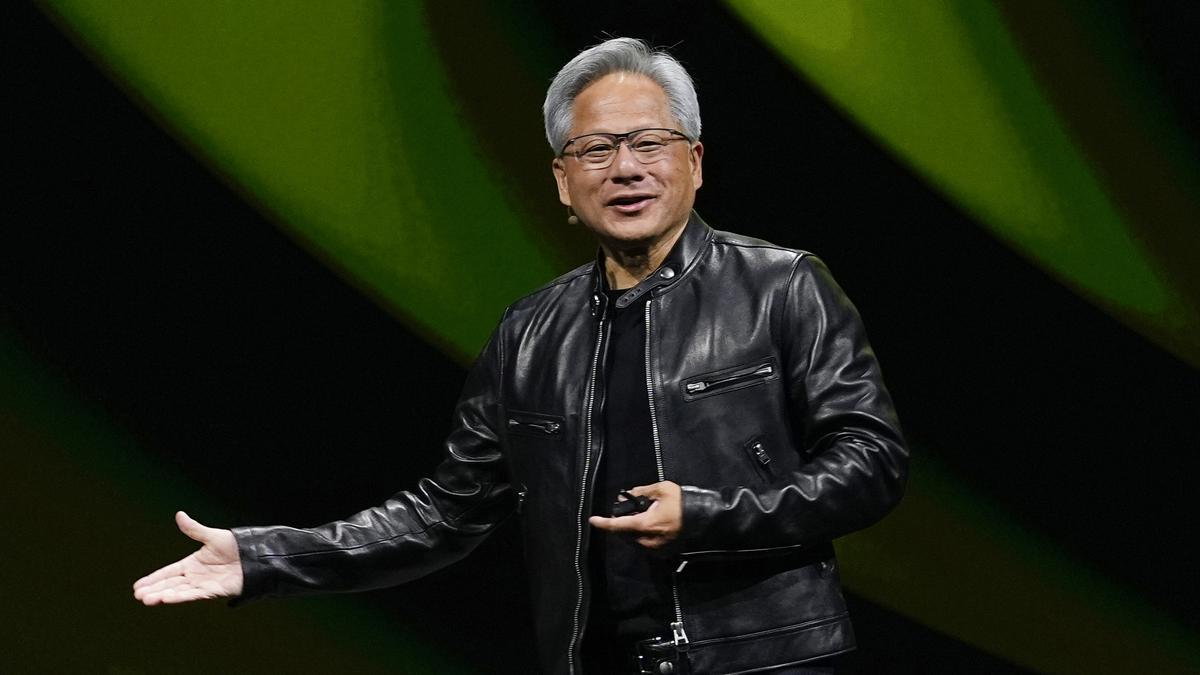Introduction
Jensen Huang, co-founder and CEO of NVIDIA, has become a transformative figure in the technology industry. Known for his relentless drive, innovative thinking, and passion for advancing computing power, Huang has steered NVIDIA from a small startup to a global powerhouse with a trillion-dollar valuation. Under his leadership, NVIDIA’s graphics processing units (GPUs) have redefined gaming, enabled breakthroughs in artificial intelligence, and fueled advancements across multiple industries. This blog explores Jensen Huang’s journey, from early life to his motivations, challenges, and vision for NVIDIA’s future.

Early Life
Jensen Huang’s journey to becoming one of tech’s most influential leaders began far from Silicon Valley. Born in Taipei, Taiwan in 1963, Huang and his family immigrated to the United States as a child, settling in Thailand before moving to the U.S. when he was 9 years old.
During his teenage years, Huang attended Oneida Baptist Institute in Kentucky, where he and his brother were enrolled as boarding students. The school’s strict discipline and focus on both academics and character development left a lasting impression on him. It was here that Huang began to develop his work ethic and determination.
What many don’t know is that Huang’s first passion wasn’t technology – it was tennis. He spent countless hours practicing on the court, learning valuable lessons about dedication and continuous improvement that would later translate into his business career. Although he was a dedicated athlete, his academic interests began to take center stage, particularly in mathematics and science.
Huang’s first meaningful encounter with computers came during his high school years in Oregon, where he had access to early personal computers. This sparked his interest in technology, though at the time, few could have predicted he would later revolutionize the computing industry.
The foundation of Huang’s success was laid in these early years – his immigrant experience taught him adaptability, his boarding school years instilled discipline, and his education provided the technical expertise that would eventually lead to the founding of NVIDIA in 1993.
Professional Life And Motivation To Start NVIDIA
Huang’s early career was shaped by roles at AMD and LSI Logic, where he developed an in-depth understanding of computer architecture and graphics. While working in the industry, Huang recognized a gap in computing power for graphical applications and envisioned a solution that would redefine the role of graphics processing. Motivated to address gaming and high-performance computing limitations, Huang co-founded NVIDIA in 1993, aiming to revolutionize the computing landscape. NVIDIA began as a modest startup with just a few employees, but it quickly grew under Huang’s visionary leadership.
The Breakthrough With GPUs
The breakthrough for NVIDIA came in 1999 with the launch of the GeForce 256, the world’s first graphics processing unit (GPU). This GPU was designed specifically to handle graphics-intensive applications, marking a paradigm shift in computing by offloading complex graphical computations from the CPU. This innovation not only transformed the gaming industry but also laid the foundation for applications in scientific computing, artificial intelligence, and data centers. Huang’s foresight in focusing on GPUs at a time when most were fixated on CPUs was pivotal, positioning NVIDIA as a leader in high-performance graphics and computing.
Mindset And Mentality: What Drives Jensen Huang?
Jensen Huang’s success is fueled by a mindset centered on long-term vision, continuous learning, and resilience. Known for his “never settle” mentality, he frequently pushes his teams to innovate beyond conventional boundaries. His approach combines a deep technical understanding with sharp business acumen, enabling him to anticipate trends and navigate NVIDIA’s path through the evolving tech landscape.
Huang also emphasizes a culture of “intellectual honesty,” encouraging employees to address challenges openly and innovate without fear of failure. This culture has fostered a company that is agile, bold, and consistently at the forefront of technology. Huang’s belief that “you don’t need to be the biggest to be the best” has propelled NVIDIA to focus on excellence, rather than competing on scale alone.
NVIDIA’s Trillion-Dollar Valuation And Huang’s Remarks
NVIDIA achieved a trillion-dollar market valuation in 2023, a milestone that cemented its status as one of the most valuable companies in the world. Huang described this achievement as “validation of a vision,” reflecting on how far the company has come from its humble beginnings. He attributes this valuation not just to financial success, but to NVIDIA’s transformative impact on the world, particularly in AI and computing power. Huang emphasizes that this valuation is a responsibility to keep innovating and providing tools that can address real-world challenges.

Struggles Along The Way
Huang’s journey hasn’t been without struggles. NVIDIA faced significant challenges in its early years, competing against larger, established companies in a volatile industry. Huang led the company through various crises, including financial setbacks, stiff competition, and the challenge of staying relevant amid rapid technological advancements. In recent years, NVIDIA has also faced scrutiny regarding its dominance and ethical responsibilities in AI and computing. Despite these hurdles, Huang’s resilience, adaptability, and vision have guided NVIDIA through turbulent times, transforming obstacles into opportunities for growth.
Early Financial Hurdles And Market Skepticism
In NVIDIA’s early years, Huang and his team faced an uphill battle in securing funding and gaining market recognition. The company began during a period when Silicon Valley was crowded with tech startups, all competing for limited venture capital. Huang’s vision for GPUs was revolutionary, yet not fully understood by the market or investors.
Intense Competition And Industry Giants
As NVIDIA grew, it faced stiff competition from tech giants like Intel and AMD, companies with significantly larger budgets and established market presence. These competitors sought to enter the GPU market, sometimes imitating NVIDIA’s innovations or attempting to outmaneuver the company with new offerings. Huang responded by positioning NVIDIA as a specialist in GPUs and pushing innovation at a relentless pace, which eventually helped NVIDIA outperform larger competitors in specific niches, particularly in gaming and high-performance computing.
Technical Setbacks And Product Failures
Throughout its history, the company encountered technical setbacks, some of which led to costly delays or even failed products. For example, certain GPU models encountered production or performance issues that hindered their market success, which had a financial impact on the company. These failures tested Huang’s resilience, as he had to continually motivate his team and investors to persevere.
Market Crises And The Dot-Com Bubble
NVIDIA’s early years also coincided with the volatility of the dot-com bubble. During the bubble’s collapse in the early 2000s, many tech companies suffered, with several going out of business. His leadership during this turbulent period allowed NVIDIA to emerge relatively unscathed, while many competitors failed to recover.

Global Supply Chain Constraints And Chip Shortages
In recent years, NVIDIA faced significant supply chain disruptions, particularly during the global chip shortage exacerbated by the COVID-19 pandemic. As demand for GPUs surged, especially in gaming, AI, and cryptocurrency mining, NVIDIA struggled to meet demand due to limited chip supply. These constraints impacted revenues and created customer dissatisfaction. Huang’s response included diversifying supply chains and forming partnerships to stabilize production.
His struggles, far from deterring him, fueled his determination to create a lasting impact. Jensen Huang’s story is a testament to the power of perseverance and vision, proving that the most significant breakthroughs often come from facing, and ultimately overcoming the greatest challenges.
Philosophy on NVIDIA: Building A Legacy Of Innovation
Huang’s philosophy for NVIDIA centers on creating technology that shapes the future. He often describes NVIDIA not merely as a chip manufacturer, but as a platform company that enables other industries to innovate. Whether through NVIDIA’s CUDA software platform or its advancements in AI and deep learning, Huang envisions NVIDIA as an enabler of breakthroughs across domains, from healthcare to self-driving cars. His focus on building a sustainable and impactful company rather than just a profitable one is evident in NVIDIA’s continual investment in research and development.
A Platform-First Approach To Technology
Huang views NVIDIA not simply as a chip manufacturer but as a platform provider that enables others to build upon NVIDIA’s innovations. Central to this philosophy is the CUDA platform, a programming model that allows GPUs to be used for general-purpose computing, which NVIDIA introduced in 2006. CUDA made it possible for scientists and engineers to harness the power of GPUs for tasks far beyond graphics, such as deep learning, simulation, and high-performance computing.
Innovation-Driven Culture And Intellectual Honesty
Huang has embedded a culture of “intellectual honesty” at NVIDIA, encouraging employees to question assumptions, confront challenges directly, and learn from setbacks. He believes that true innovation requires transparency and a willingness to address hard truths. This open culture supports a work environment where employees feel empowered to take risks, push limits, and explore new ideas without fear of failure.
Building For The Future: AI, Autonomous Systems, And The Metaverse
NVIDIA’s AI focus, driven by Huang’s foresight, has positioned the company as a dominant player in machine learning and deep learning, providing critical infrastructure for industries ranging from healthcare to finance. With NVIDIA’s Omniverse platform, Huang sees an opportunity to shape the future of virtual collaboration and the Metaverse, creating a space where people and organizations can work together in a shared digital environment. This long-term vision means that NVIDIA’s innovations are not just reactive—they are proactive efforts to define the future of technology.
Responsibility And Ethical Innovation
In response to the rising concerns about data privacy, bias in AI algorithms, and the environmental impact of data centers, Huang has advocated for practices that minimize negative effects and maximize positive impact. This commitment to ethical innovation is part of NVIDIA’s philosophy, reinforcing the company’s role not just as a technology leader, but as a responsible corporate citizen in the global tech landscape.
Future Visions: What Lies Ahead For Jensen Huang And NVIDIA?
Looking to the future, Huang has ambitious plans for NVIDIA’s role in artificial intelligence, autonomous systems, and the Metaverse. He envisions NVIDIA as a cornerstone for the next generation of AI applications, working on projects that will enable new levels of automation, creativity, and intelligence. In autonomous systems, he aims to position NVIDIA as a leader, powering self-driving cars, drones, and robots across industries. Huang is also excited about the Metaverse’s potential, seeing NVIDIA’s Omniverse platform as a tool to create a virtual world where people can collaborate, design, and innovate together.

Conclusion
Jensen Huang’s journey from an immigrant student to the CEO of a trillion-dollar tech giant is a testament to visionary leadership and relentless innovation. Through NVIDIA, he has redefined the role of computing, impacting industries and society at large. Huang’s story underscores the importance of resilience, long-term vision, and a commitment to continuous learning. As NVIDIA embarks on its next chapter, guided by Huang’s forward-looking philosophy, the world watches with anticipation to see how he will further shape the future of technology and inspire new generations of innovators.
Visit WOOCUR, for more such blogs
Thank you 🙂






